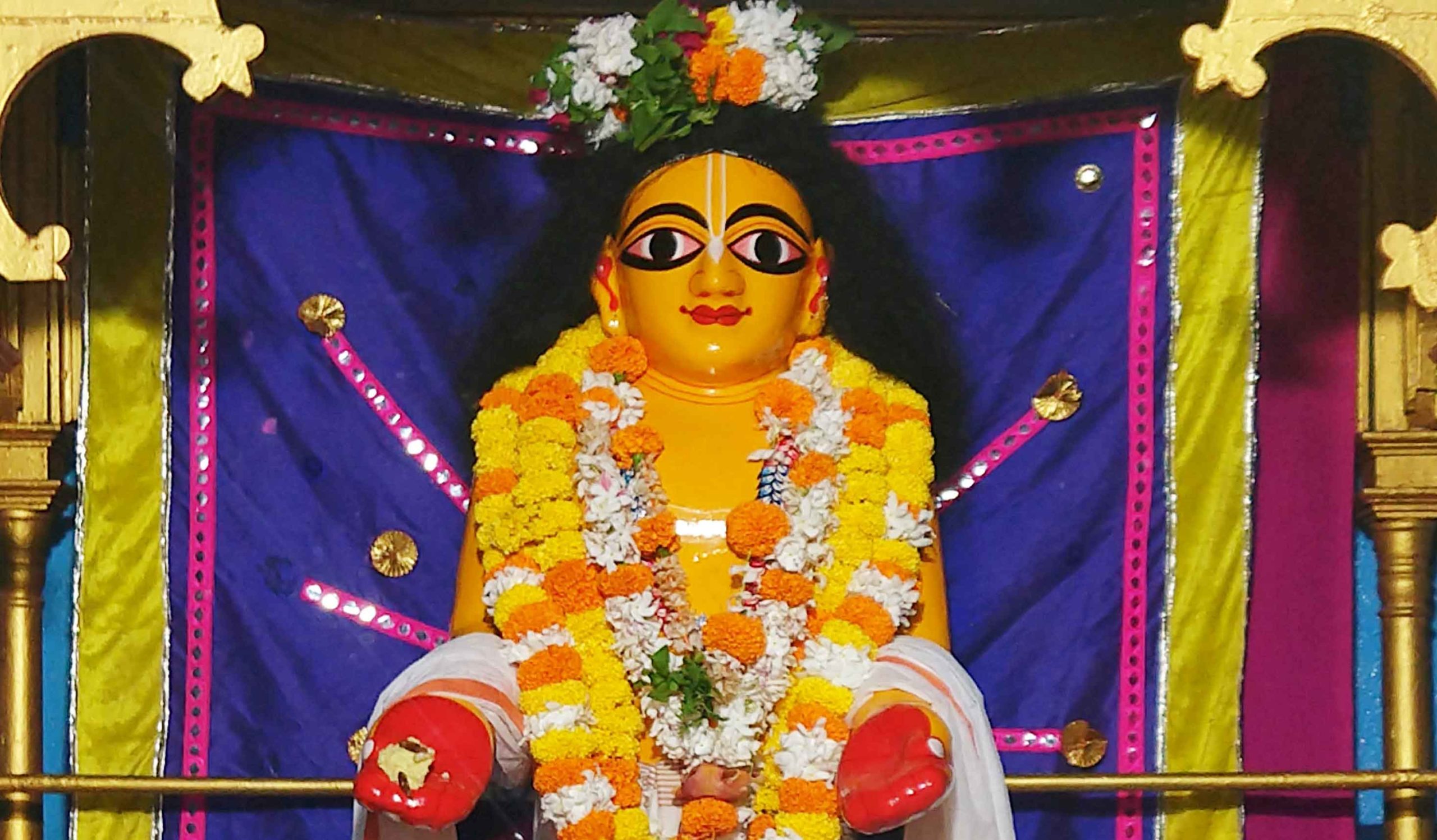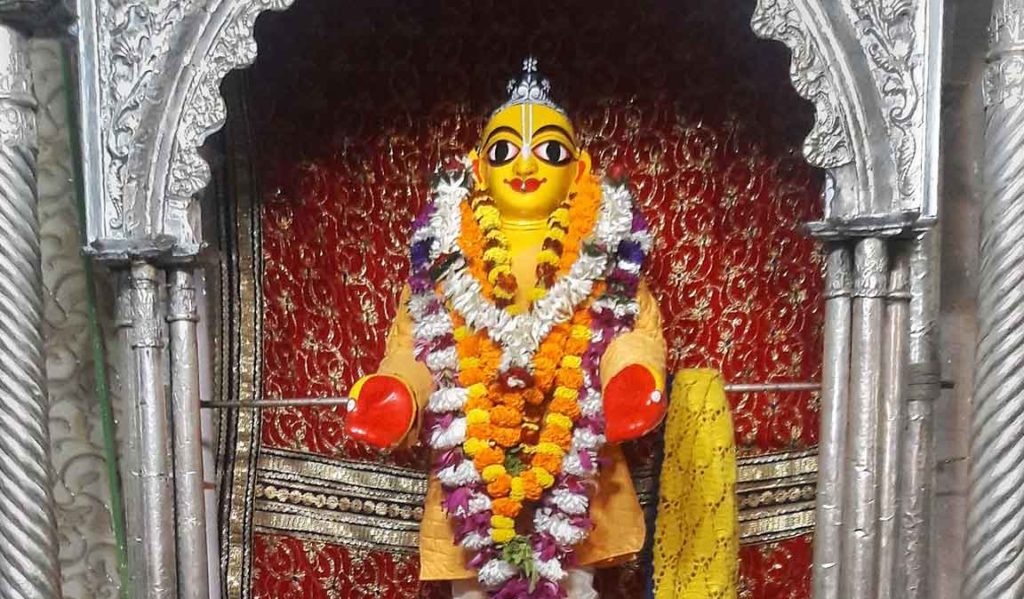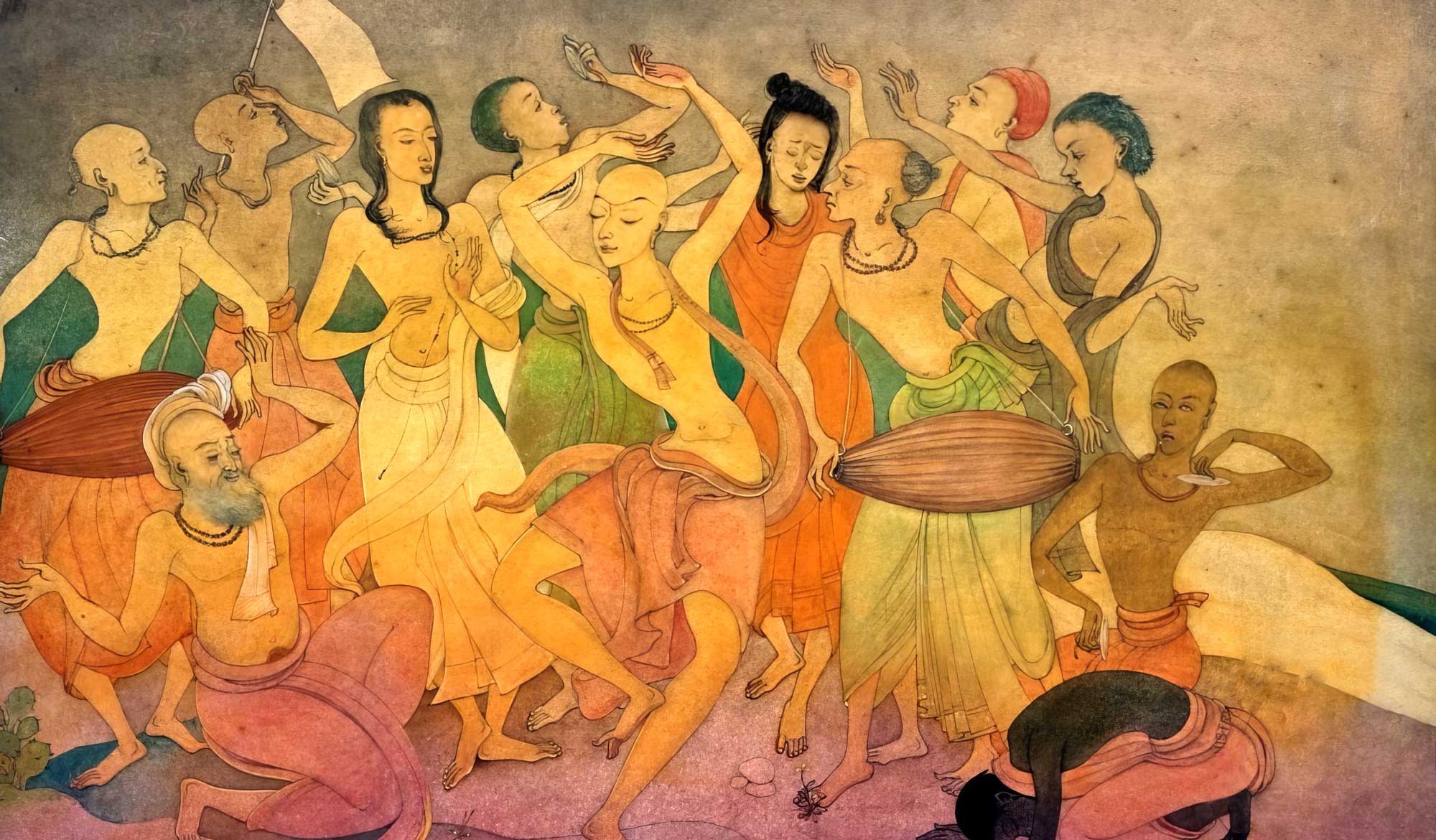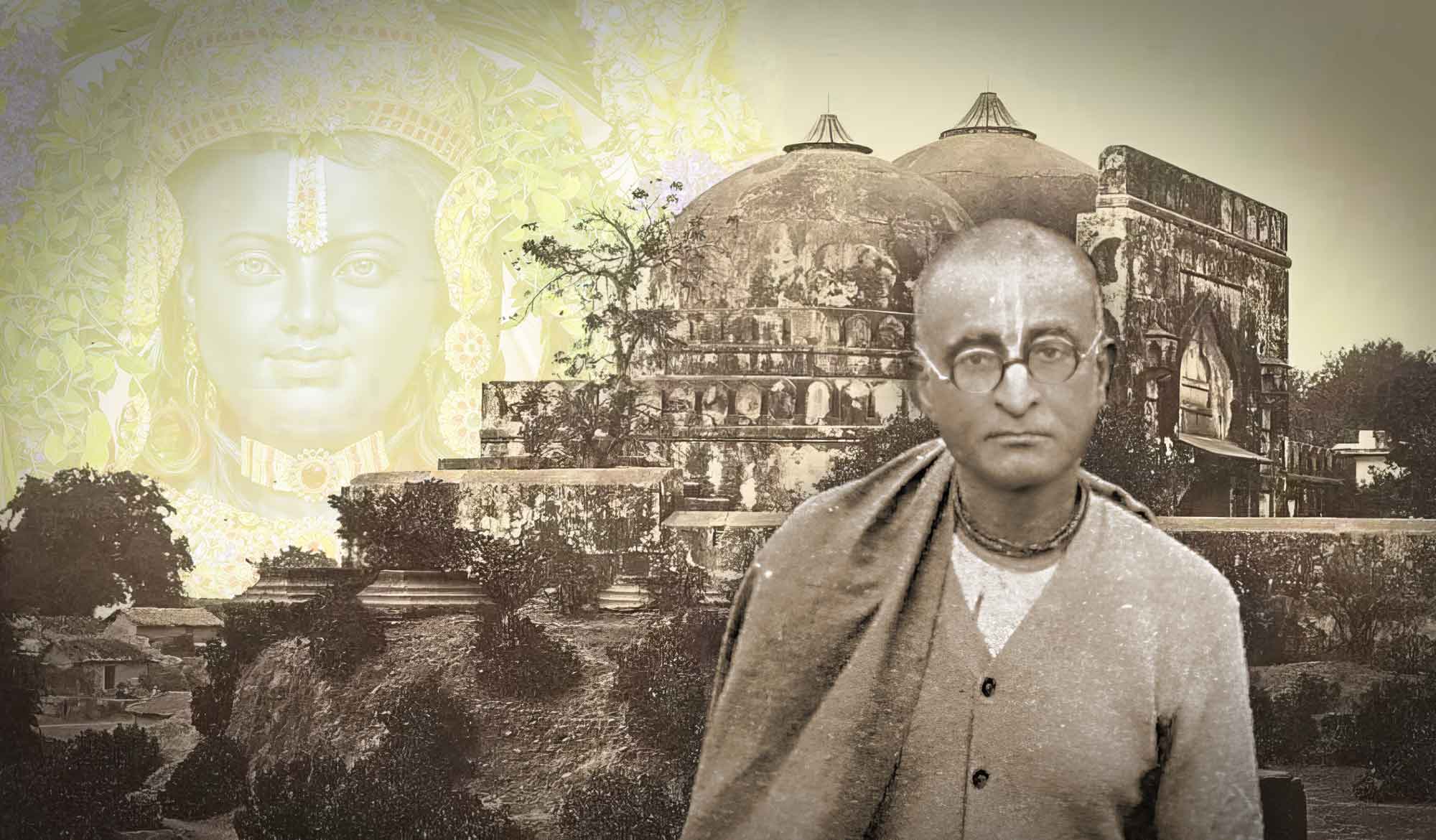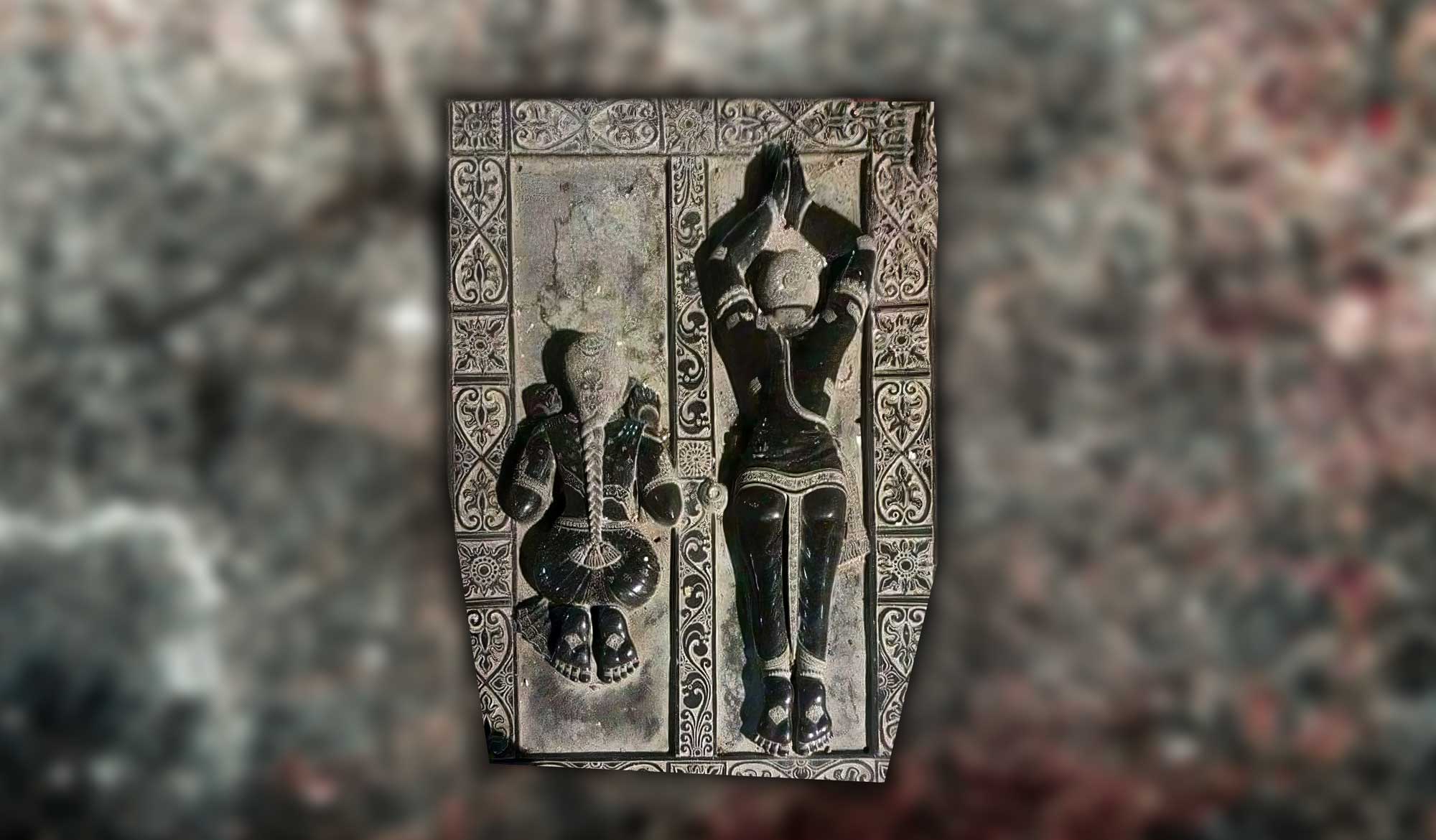Overview
'Śrī Nityānanda Dvādaśakam' (Twelve Prayers in Praise of Lord Nityananda) is a Sanskrit composition by Śrīla Śrīdhara Deva Gosvāmī Mahārāja delineating the ontological position and appearance of Śrī Nityānanda Prabhu.
(1)
yo ’nanto ’nanta-vaktrair niravadhi hari-saṁkīrtanaṁ saṁvidhatte
yo vā dhatte dharitrīṁ śirasi niravadhi kṣudra-dhūlī kaṇeva
yaḥ śeśaś-catra-śayyāsana-vasana-vidhaiḥ sevate te yad-arthāḥ
śrī-nityānanda-candraṁ bhaja bhaja satataṁ gaura-kṛṣṇa-pradaṁ tam
Lord Nityānanda’s representation as Ananta Śeṣa possesses unlimited mouths which propagate and glorify Lord Hari’s Holy Names and attributes. Ananta Śeṣa constantly holds the weight of the Earth planet upon His innumerable hoods as if it were an insignificant particle of dust. Ananta Śeṣa serves the Lord in several ways, manifesting Himself as the Lord’s personal umbrella, resting place, and clothing. Let us eternally worship that great personality Śrī Nityānanda-candra, who freely grants the association of Śrī Gaurāṅgadeva, who is none other than Lord Kṛṣṇa.
(2)
aṁśair yaḥ kṣīraśāyī sakala bhuvanapaḥ sarva jīvāntarastho
yo vā garbhodaśāyī-daśa-śata-vadano veda-sūktair vigītaḥ
bramāṇḍāśeṣa garbhā prakṛti-pati-patir jīva-saṅghāśrayāṅgaḥ
śrī nityānanda-candraṁ bhaja bhaja satataṁ gaura-kṛṣṇa-pradaṁ tam
Lord Nityānanda’s partial manifestation as Kśīrodakaśāyī Viṣṇu functions as the preservation principle of the entire universal creation, and is localized within every soul (paramātma). Another eminent expansion of Lord Nityānanda is Garbhodaśāyī Viṣṇu, that all-imposing figure whose thousands of heads are eulogized in the Vedic orations. Lord Nityānanda’s presence is further extended in His expansion as Kāraṇodaśāyī Viṣṇu, the supplying principle encompassing unlimited universes. Lord Nityānanda is the master of the Lord of material nature, Kāraṇodaśāyī Viṣṇu, who is the shelter of all living entities. Let us eternally worship that great personality Śrī Nityānanda-candra, who freely grants the association of Śrī Gaurāṅgadeva, who is none other than Lord Kṛṣṇa.
(3)
yasyāṁśo vyuha-madhye vilasati parama-vyomni saṁkarṣaṇākhya
ātanvan śuddha-sattvaṁ nikhila-hari-sukhaṁ cetanaṁ līlayā ca
jīvāhaṅkāra-bhāvāspada iti kathitaḥ kutracij-jīvavad yaḥ
śrī-nityānanda-candraṁ bhaja bhaja satataṁ gaura-kṛṣṇa-pradaṁ tam
Lord Nityānanda’s presence is further extended within the spiritual abode of Vaikuṇṭha in His partial manifestation known as Saṅkarṣaṇa. In Vaikuṇṭha, Lord Saṅkarṣaṇa performs spiritual Pastimes which are fully transcendental, situated in pure goodness, and all-pleasing to Lord Hari. As mentioned in the revealed scriptures, Lord Nityānanda is the individual temperament of ego existing within the living entity, and He sometimes appears just like an ordinary living entity. Let us eternally worship that great personality Śrī Nityānanda-candra, who freely grants the association of Śrī Gaurāṅgadeva, who is none other than Lord Kṛṣṇa.
(4)
yaścādi vyuha-madhye prabhavati sagaṇo mūla-saṅkarṣaṇākhyo
dvārāvatyāṁ tad-ūrddhe madhupuri vasati prābhavākhyo vilāsaḥ
sarvāṁśī rāma-nāmā vrajapuri ramate sānujo yaḥ svarūpe
śrī-nityānanda-candraṁ bhaja bhaja satataṁ gaura-kṛṣṇa-pradaṁ tam
Lord Nityānanda who is the fountainhead of the primary Saṅkarṣaṇa, exists in full splendour separate from the original quadruple expansion, and is known as Mūla Saṅkarṣaṇa. That all-attractive personality, Śrī Saṅkarṣaṇa, performs His wonderful Pastimes in the spiritual realm in the regions known as Mathurā and Dvārakā. The transcendental city of Dvārakā is situated just below the city of Mathurā. It is in these spiritual places that Lord Saṅkarṣaṇa and His associates Aniruddha and Pradyumna exhibit Their particular pastimes scripturally known as prabhāva-vilāsaḥ. Nityānanda Prabhu in the form of Lord Balarāma is the ultimate source of all incarnations, and sportively plays in the charming village of Vrajapura with His younger brother Lord Kṛṣṇa. Let us eternally worship that great personality Śrī Nityānanda-candra, who freely grants the association of Śrī Gaurāṅgadeva, who is none other than Lord Kṛṣṇa.
(5)
śrī-kṛṣṇa-premanāmā parama-sukhamayaḥ ko’pyacintyaḥ padārtho
yad gandhāt sajjanaughā nigama-baṅhumataṁ mokṣam apy ākṣipanti
kaivalyaiśvarya-sevā-pradagaṇa iti yasyāṅgataḥ premadātuḥ
śrī nityānanda-candraṁ bhaja bhaja satataṁ gaura-kṛṣṇa-pradaṁ tam
Pure unalloyed love for Lord Krishna, which is inconceivable to all, embodies the most supreme and intense happiness. When the devotees of the Lord realize the joy of such love, they cast away the innumerable doctrines offered by the Vedas, including the soul’s emancipation. Lord Nityānanda openly bestows pure love, automatically including worship of the non-differentiated Brahman and service offered in Vaikuṇṭha, which is dominated by opulence and grandeur. Let us eternally worship that great personality Śrī Nityānanda-candra, who freely grants the association of Śrī Gaurāṅgadeva, who is none other than Lord Kṛṣṇa.
(6)
yo bālye līlayaikaḥ parama-madhurayā caikachakrānagaryyāṁ
mātā-pitror janānā matha nija-suhṛdāṁ hlādayaṁś citta-chakram
tīrthān vabhrāma sarvānupahṛta janako nyāsinā prārthitaś ca
śrī-nityānanda-candraṁ bhaja bhaja satataṁ gaura-kṛṣṇa-pradaṁ tam
When Nityānanda Prabhu was a small boy, He performed sweet and charming Pastimes in the village of Ekacakra. His Pastimes invoked the deepest heartfelt happiness in His mother, father, relatives, and close friends. Once, a renunciate arrived at the house of Nityānanda and prayed to the boy’s father for his son. Lord Nityānanda was placed in the hands of the renunciate and left to visit the holy places of pilgrimage, wandering throughout the length and breadth of India. Let us eternally worship that great personality Śrī Nityānanda-candra, who freely grants the association of Śrī Gaurāṅgadeva, who is none other than Lord Kṛṣṇa.
(7)
bhrāmaṁ bhrāmañca tīrthān yati-mukuṭa-maṇi mādhavendra prasaṅgāt
labdhollāsaḥ pratikṣya prakaṭita caritaṁ gaura-dhāmājagāma
śrī-gauraḥ śrīnivāsādibhir api yamāvāpālaye nandanasya
śrī nityānanda-candraṁ bhaja bhaja satataṁ gaura-kṛṣṇa-pradaṁ tam
Nityānanda travelled from place to place with the crest jewel of the renounced order, Śrī Mādhavendra Purī. In the pure association of Mādhavendra Purī, Lord Nityānanda experienced the most joyful symptoms of ecstasy. After this, the Lord journeyed to Nabadwīp, where He eagerly waited for Śrī Caitanya Mahāprabhu to reveal His benevolent nature to the world. Shortly following Nityānanda’s arrival. Lord Caitanyadeva Himself, in the company of Śrīnivās Paṇḍita and Haridāsa Ṭhākura, went to the house of Śrī Nandanācārya and found Nitāi there. Let us eternally worship that great personality Śrī Nityānanda-candra, who freely grants the association of Śrī Gaurāṅgadeva, who is none other than Lord Kṛṣṇa.
(8)
prāptājño gaura-candrādakhilajana gaṇoddhāra-nāma-pradāne
yaḥ prāpya dvau surāpau kalikaluṣa-hatau bhrātarau brahma-daityau
gāḍha-prema prakāśaiḥ kṛta-rudhira-vapuś cāpi tāv-ujjahāra
śrī-nityānanda-candraṁ bhaja bhaja satataṁ gaura-kṛṣṇa-pradaṁ tam
Nityānanda Prabhu was ordered by the golden moon, Śrīman Mahāprabhu, to deliver the masses by the wide distribution of Lord Krishna’s Holy Names. One evening, Lord Nityānanda encountered those two drunken and sinful brothers, Jagāi and Mādhāi, who were previously brahma-daitya demons of the first order, acting under the devastating spell of Kali-yuga. Suddenly, Nitāi was attacked by Mādhāi, whereupon His body became smeared with blood. In response, Lord Nitāi exhibited deep affection for the welfare of the two brothers and rescued them from their abominable condition. Let us eternally worship that great personality Śrī Nityānanda-candra, who freely grants the association of Śrī Gaurāṅgadeva, who is none other than Lord Kṛṣṇa.
(9)
sākṣād-gauro gaṇānāṁ śirasi yad avadhūtasya kaupīna-khaṇḍaṁ
saṁdharttuñ cādideśāsava yavana vadhū spṛṣṭa-dṛṣṭo ’pi vandyaḥ
brahmādyānām apīti prabhu-parihṛtakānām api sveṣṭa-pīṭaḥ
śrī-nityānanda-candraṁ bhaja bhaja satataṁ gaura-kṛṣṇa-pradaṁ tam
Lord Gaurāṅga instructed His family members and followers to wear pieces of Lord Nityānanda’s kaupīna respectfully on their bodies. So pure and impeccable is the character of Nitāi that even if He is seen holding the hand of a Yavana’s wife and carrying a bottle of wine, nonetheless He remains supremely worshippable by the great demigods such as Lord Brahmā. Lord Nityānanda is also the desirable object of those exalted devotees who can steal away the heart of the Lord. Let us eternally worship that great personality Śrī Nityānanda-candra, who freely grants the association of Śrī Gaurāṅgadeva, who is none other than Lord Kṛṣṇa.
(10)
uddharttuṁ jñāna-karmmādy-apahata-caritān gaura-candro yad āsau
nyāsaṁ kṛtvā tu māyā mṛgamanusṛtavān grāhayan kṛṣṇa-nāma
tach-cāyevānvadhāvat sthala-jala-gahane yo ’pi tasyeṣṭa-ceṣṭaḥ
śrī nityānanda-candraṁ bhaja bhaja satataṁ gaura-kṛṣṇa-pradaṁ tam
Accepting the renounced order of life and distributing the Lord’s Holy Names, Lord Gaurāṅga chased after those souls who had been spoiled by the doctrines of dry argumentative logic and motivated fruitive activity. Like Lord Gaurāṅga’s own shadow, Nitāi Prabhu accompanied the Lord over land and through rivers, waterways, and jungles. In addition, Lord Nityānanda is the desired goal of all Gaurāṅga’s endeavours. Let us eternally worship that grand personality Śrī Nityānanda-candra, who can freely grant the association of that golden Lord Śrī Gaurāṅgadeva, who is none other than Lord Kṛṣṇa.
(11)
śrī-rādhā-prema-lubdho divasa-niśi-tadāsvāda-mattaika līlo
gauro yañcādi deśa svaparikara-vṛtaṁ kṛṣṇa-nāma pradātum
gauḍe ’bādhaṁ dadau yaḥ subhaga-gaṇa-dhanaṁ gaura-nāma-prakāmaṁ
śrī-nityānanda-candraṁ bhaja bhaja satataṁ gaura-kṛṣṇa-pradaṁ tam
Day and night Lord Caitanya was intoxicated with the intense desire to taste the sweetness of Śrī Rādhikā’s divine love for Krishna. Śrīman Mahāprabhu instructed Lord Nityānanda and His associates to go out and profusely distribute the Holy Names of Lord Krishna. However, Lord Nityānanda instead plentifully distributed Lord Gaurāṅga’s Name, the most precious fortune available to the living entities, with no impediment at all. Let us worship that great personality Śrī Nityānanda-candra, who freely grants the association of Śrī Gaurāṅgadeva, who is none other than Lord Kṛṣṇa.
(12)
śrī-rādhā-kṛṣṇa-līlā-rasa-madhura-sudhāsvāda-śuddhaika-mūrtau
gaure śraddhāṁ dṛḍhāṁ bho prabhu-parikara-samrāṭ prayacchādhame ’smin
ullaṅghyāṅghriṁ hi yasyākhila-bhajana-kathā svapnavach caiva mithyā
śrī-nityānanda-candraṁ patita-śaraṇa-daṁ gaura-daṁ taṁ bhaje ’ham
O Nityānanda Prabhu, emperor amidst the personal associates of Śrīman Mahāprabhu! Kindly grant this fallen soul deep and resolute faith in that pure and divine figure of Śrī Gaurāṅga. Lord Gaurāṅga’s personality exclusively embodies the sweet nectar relished deep within the devotional mellows of Śrī Śrī Rādhā-Krishna’s Pastimes. But if Your lotus feet are over-looked, than all so-called devotional orations and prayers meant for the highest worship become false, like a dream. I worship You, that great personality Nityānanda-candra, who openly bestows shelter to the most fallen souls, freely granting the association of Śrī Gaurāṅgadeva.
Related Articles, Songs and Prayers
- Śrī Gaura-hari Kusuma Stavāṣṭākam by Śrīla Bhakti Rakṣaka Śrīdhara Deva Gosvāmī
- Śrī Kusumañjalī (An Offering of Flowers) by Śrīla Bhakti Rakṣaka Śrīdhara Deva Gosvāmī
- Śrī Nāma Māhātmya (The Glories of the Holy Name) by Śrīla Bhakti Rakṣaka Śrīdhara Deva Gosvāmī
- Śrī Nityānanda Dvādaśakam by Śrīla Bhakti Rakṣaka Śrīdhara Deva Gosvāmī
- Śrīmad Bhaktivinoda Viraha Daśakam by Śrīla Bhakti Rakṣaka Śrīdhara Deva Gosvāmī
- Śrī Śrī Gaurasundara Āvirbhava Vāsare by Śrīla Bhakti Rakṣaka Śrīdhara Deva Gosvāmī
- ‘The Best of Thieves’ – An Illumination by Śrīla Bhakti Rakṣaka Śrīdhara Deva Gosvāmī
- Mā Muñca Pañca-daśakam (Fifteen Verses Praying Not to be Abandoned) by Śrīla Śrīdhara Deva Gosvāmī Mahārāja
- Śrīla Sarasvatī Gosvāmyāṣṭakam by Śrīla Śrīdhara Deva Gosvāmī Mahārāja
- Vṛndāvane Bhajana (Worship in Vṛndāvana) by Śrīla A.C. Bhaktivedānta Swami Prabhupāda
- Vaiśiṣṭyāṣṭaka (Eight Stanzas of Significance) by Śrīla A.C. Bhaktivedānta Swami Prabhupāda
- Svasti No Gaura-vidhur Dadhātu (May the Moon-like Gaura Bestow Auspiciousness) by Śrīla B.P. Purī Mahārāja
- A Prayer Composed on the Occasion of the Disappearance of Śrīla Gadādhara Paṇḍita by Śrīla Bhakti Pramoda Purī Gosvāmī
- Śrī Śrī Gaura Gopāla Praśasti (In Praise of Śrī Śrī Gaura Gopāla) by Śrīla Bhakti Pramoda Purī Gosvāmī
- Viraha-Gītikā (A Song of Separation) by Śrīla Bhakti Pramoda Purī Mahārāja
- Jaya Rādhā-Mādhava by Śrīla Bhakti Gaurava Narasiṅgha Mahārāja
- Purport to Śrīla Prabhupāda-līlā Smaraṇa-Maṅgala Stotram by Śrīla Bhakti Gaurava Narasiṅgha Mahārāja
- Purī Mahārāja’s Praṇāma Mantra by Śrīla Bhakti Gaurava Narasiṅgha Mahārāja
- Śrī Guru-viraha Ṣaṭakam – Six Verses in Separation from Śrī Guru by Swami B.V. Giri
- Śrī Guru Praṇāma Anuvākya – An Explanation of Śrīla Guru Mahārāja’s Praṇāma Mantra by Swami B.V. Giri
Further Reading from the Bhaktivinoda Institute
- Gītā-mālā (A Garland of Songs) by Śrīla Bhaktivinoda Ṭhākura (Songbook)
- Kalyāṇa Kalpataru (‘The auspicious Desire Tree’) by Śrīla Bhaktivinoda Ṭhākura (Songbook)
- Śaraṇāgati (Surrendered to the Lord’s Shelter) by Śrīla Bhaktivinoda Ṭhākura (Songbook)
- Gītāvalī (A Collection of Songs) by Śrīla Bhaktivinoda Ṭhākura (Songbook)
- Bāula Saṅgīta by Śrīla Bhaktivinoda Ṭhākura (Songbook)
- Sevā Lālasā (Hankering for Service) by Śrīla Bhaktivinoda Ṭhākura (Songbook)
- Śrī Godruma-candra Bhajanopadeśa by Śrīla Bhaktivinoda Ṭhākura
- Śrī Kṛṣṇacandra by Śrīla Bhaktivinoda Ṭhākura
- Śrī Gīta Govinda Introduction by Śrīla Bhaktivinoda Ṭhākura
- Poems by Śrīla Bhaktivinoda Ṭhākura
Prema Dhāma Deva Stotram with the Narasiṅgha Sevaka Commentary – Verses 61-65
In verses 61 to 65 of 'Prema Dhāma Deva Stotram', Śrīla Śrīdhara Mahārāja narrates the pastime of Śrī Caitanya at Caṭaka Parvata In Purī and explains how the scriptures produced by Brahmā and Śiva are ultimately searching for the personality of Mahāprabhu who is merciful too all jīvas, no matter what their social position.
Prabhupāda Śrīla Sarasvatī Ṭhākura’s Visit to Ayodhyā
With the forthcoming observance of Śrī Rāma Navamī, we present 'Prabhupāda Śrīla Sarasvatī Ṭhākura’s Visit to Ayodhyā' written by Śrīla Bhaktisiddhānta Sarasvatī Ṭhākura Prabhupāda from The Gaudīyā magazine, Vol 3. Issue 21/ In December 1924, after visiting Benares and Prāyāga, Sarasvatī Ṭhākura visited the birth-site of Śrī Rāmācandra in Ayodhyā.
Śaraṇāgati – The Only Path to Auspiciousness
In this article, 'Śaraṇāgati - The Only Path to Auspiciousness', Dhīra Lalitā Dāsī analyses the process of śaraṇāgati (surrender) beginning with śraddhā (faith). She also discusses the role of śāstra and the Vaiṣṇava in connection with surrender.
Ātma Samīkṣā – The Value of Introspection
In this article, "Ātma Samīkṣā – The Value of Introspection" Kalki Dāsa highlights the importance of introspection in the life of a devotee and especially in relation to the worldly environment that surrounds us. He also explains how transcendental sound influences our capacity to introspect.
Prema Dhāma Deva Stotram with the Narasiṅgha Sevaka Commentary – Verses 61-65
In verses 61 to 65 of 'Prema Dhāma Deva Stotram', Śrīla Śrīdhara Mahārāja narrates the pastime of Śrī Caitanya at Caṭaka Parvata In Purī and explains how the scriptures produced by Brahmā and Śiva are ultimately searching for the personality of Mahāprabhu who is merciful too all jīvas, no matter what their social position.
Prabhupāda Śrīla Sarasvatī Ṭhākura’s Visit to Ayodhyā
With the forthcoming observance of Śrī Rāma Navamī, we present 'Prabhupāda Śrīla Sarasvatī Ṭhākura’s Visit to Ayodhyā' written by Śrīla Bhaktisiddhānta Sarasvatī Ṭhākura Prabhupāda from The Gaudīyā magazine, Vol 3. Issue 21/ In December 1924, after visiting Benares and Prāyāga, Sarasvatī Ṭhākura visited the birth-site of Śrī Rāmācandra in Ayodhyā.
Śaraṇāgati – The Only Path to Auspiciousness
In this article, 'Śaraṇāgati - The Only Path to Auspiciousness', Dhīra Lalitā Dāsī analyses the process of śaraṇāgati (surrender) beginning with śraddhā (faith). She also discusses the role of śāstra and the Vaiṣṇava in connection with surrender.
Ātma Samīkṣā – The Value of Introspection
In this article, "Ātma Samīkṣā – The Value of Introspection" Kalki Dāsa highlights the importance of introspection in the life of a devotee and especially in relation to the worldly environment that surrounds us. He also explains how transcendental sound influences our capacity to introspect.


